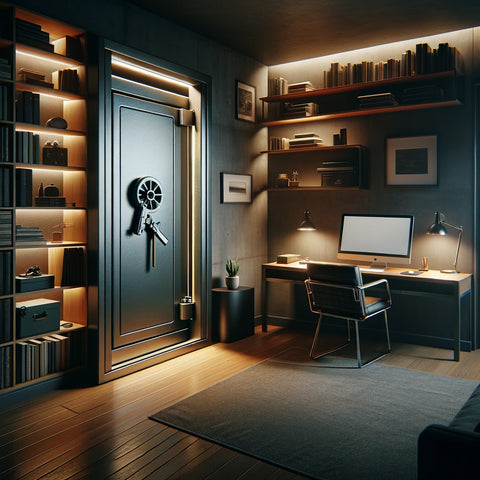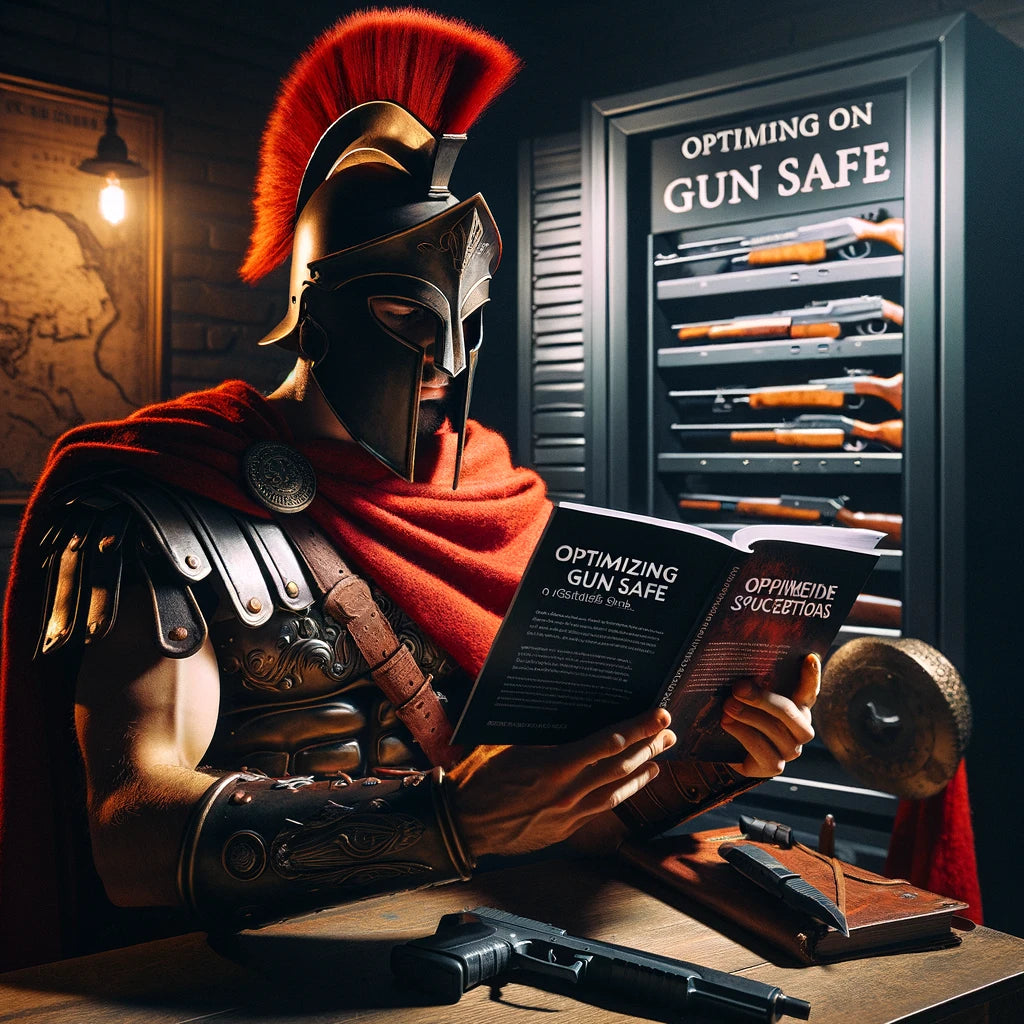Ensuring the safety of your firearms is not just about ownership responsibility; it's about creating a secure environment for everyone in your home. Safes play a pivotal role in this, offering a blend of accessibility for the owner and impenetrable security against unauthorized access. But the question remains: are you maximizing the potential of your gun safe?
Join us as we navigate through essential tips, debunk common myths, and offer step-by-step advice to optimize your gun safe usage, ensuring peace of mind through heightened security and accessibility.
Strategic Placement for Your Gun Safe

Finding the perfect spot for your gun safe goes beyond mere convenience; it's a strategic decision that balances accessibility with security. The ideal location ensures that your firearms are readily available during emergencies while keeping them out of reach of unauthorized users and protecting them from environmental threats. Let's navigate through the considerations and recommendations for placing your gun safe.
Home Office or Bedroom: Often, the bedroom or home office is considered prime real estate for your gun safe. These locations offer privacy and ease of access, especially during nighttime emergencies. Placing it in a closet or a concealed corner can add an extra layer of secrecy while keeping it within arm's reach.
Hidden Areas: For added security, consider more covert locations such as behind a false wall, inside a custom-built furniture piece, or beneath the floorboards. These spots make your gun safe virtually invisible to the untrained eye, significantly reducing theft risks.
Environmental Considerations: Whichever location you choose, ensure it's free from environmental hazards. Avoid areas prone to moisture or extreme temperature fluctuations, as these can damage your firearms or the safe's integrity over time. Utilizing dehumidifiers or placing your safe away from windows and water sources can mitigate these risks.
Accessibility vs. Visibility: While it's crucial to have your gun safe accessible to you and other authorized users, it's equally important to keep it hidden from visitors or potential intruders. Assess the visibility of your chosen spot, especially in relation to the main entry points of your home.
Avoiding Common Placement Errors: Steer clear of high-traffic areas where the safe could attract unnecessary attention. Similarly, avoid placing the safe in isolated areas of the house, like the basement or attic, where accessing it quickly during emergencies could be challenging.
By thoughtfully considering these factors, you can secure a location that offers peace of mind, knowing that your firearms are stored safely and efficiently. Remember, the key is to balance accessibility with security, ensuring your gun safe serves its purpose effectively.
Evaluating Gun Safe Effectiveness
The effectiveness of gun safes is a topic shrouded in myths and misconceptions, leading many to question their reliability and security. At the core of this debate is the essential purpose of a gun safe: to prevent unauthorized access to firearms while allowing the rightful owner access in times of need. But how effective are gun safes in reality, and what factors determine their security level?
1. Myths vs. Facts
Myth: All gun safes offer the same level of protection.
Fact: The security level of gun safes varies significantly based on their construction, locking mechanism, and resistance to tampering.
Myth: Gun safes are easy to break into with the right tools.
Fact: High-quality gun safes are designed to withstand break-in attempts, including drilling, prying, and cutting, for extended periods.
Myth: Biometric safes are always the best option.
Fact: While biometric safes offer quick access, their effectiveness can vary based on technology quality, battery life, and maintenance.
2. Effectiveness Criteria

Materials Used: The thickness and type of metal used in the construction of the gun safe directly impact its ability to resist forced entry. Heavier gauge steel is more resistant to cutting and drilling.
Certifications: Safes certified by recognized standards organizations have been tested for specific security features and resistance to attack. Look for certifications from UL (Underwriters Laboratories) or similar entities.
Additional Security Features: Features like re-lockers, anti-pry bars, and hard plates around the lock area enhance a safe's effectiveness against break-ins.
3. Comparative Analysis
Keypad Safes: Provide a balance of security and convenience. They rely on a numeric code, which doesn't require physical keys that can be lost or stolen.
Traditional Lock Safes: Though less convenient, they offer high security without the need for batteries or electronic components. Best for long-term storage in low-access situations.
While no safe is impenetrable, high-quality models offer significant resistance to unauthorized access, making them an essential component of firearm safety and security. By understanding the truth behind gun safe effectiveness, owners can make informed decisions to protect their firearms, their loved ones, and themselves.
Pros and Cons of Garage Storage for Gun Safes
Deciding where to place a gun safe in your home is a critical decision that impacts not only the security and accessibility of your firearms but also their preservation. The garage, often considered for its convenience and out-of-the-way location, presents a unique set of advantages and challenges for gun safe storage.
Pros
Space Efficiency: Garages typically offer more unused space compared to living areas, allowing for larger safes that can accommodate growing collections without intruding on living spaces.Cons
Increased Theft Risk: Garages are often targeted by thieves due to easier access and lower security compared to the interior of a home. A visibly placed gun safe can become a tempting target for criminals.Mitigating Risks
Enhanced Security Measures: If you choose to store your gun safe in the garage, consider implementing additional security measures such as alarm systems, motion detectors, or CCTV to deter theft.Climate Control: Use dehumidifiers, insulation, and temperature controls to mitigate environmental risks, protecting both the safe and its contents from damage.
Concealment Strategies: Keeping the safe out of plain sight can significantly reduce theft risk. Consider creative concealment options or installing the safe within a locked cabinet or closet in the garage.
By weighing the pros against the cons and taking steps to mitigate potential drawbacks, you can ensure your firearms remain secure and preserved. Ultimately, the decision should reflect your unique needs, the specifics of your garage space, and a commitment to maintaining the highest standards of gun safety and security.
The Safe Way to Move a Gun Safe

Moving a gun safe is a daunting task that requires careful planning and execution to ensure safety and prevent damage to the safe or your property. Whether you’re relocating to a new home or simply moving your safe to another room, understanding the proper steps and precautions is crucial.
1. Preparation
Empty the Safe: Remove all contents from your gun safe to reduce weight and prevent items from shifting or causing damage.Gather Necessary Equipment: Rent or purchase a heavy-duty appliance dolly, moving blankets, and straps. Ensure the dolly is rated for the weight of your safe.
Measure Doorways and Pathways: Confirm that the safe will fit through all doorways, staircases, and hallways on the route to its new location. Plan your path to avoid obstacles.
2. Packing Tips
Secure the Door: Lock the door of the safe and consider removing it if it’s detachable and doing so would significantly reduce weight. If removed, wrap the door separately in moving blankets.Wrap the Safe: Use moving blankets to wrap the entire safe, securing them with packing tape or straps. This protection minimizes scratches and dings during the move.
3. Moving Process
Recruit Assistance: Due to the weight and bulkiness of gun safes, it's essential to have several strong helpers. Never attempt to move a heavy safe alone.Position the Dolly: Tilt the safe slightly to slide the dolly underneath. Ensure the safe is centered and secure it to the dolly with straps.
Use Proper Lifting Techniques: Bend at the knees and keep your back straight when lifting or tilting the safe. Use your legs, not your back, to generate force.
Navigate Carefully: Move slowly, communicating clearly with your helpers. Take special care when navigating corners, doorways, and stairs. For stairs, a motorized stair-climbing dolly is highly recommended.
4. Installation Tips
Choose the Right Location: Before moving, ensure your new location is suitable for the safe, considering factors like floor support and environmental conditions.Anchoring the Safe: Once in place, anchor your safe to the floor or wall as appropriate. This step is crucial for preventing tipping or removal by thieves.
5. Safety Precautions
Wear Proper Attire: Use gloves for grip and closed-toe, sturdy shoes to protect your feet.Clear the Path: Ensure the route is clear of any obstacles or tripping hazards before moving the safe.
Consider Professional Movers: For extremely heavy safes or complex moving situations (like up or down multiple flights of stairs), hiring professionals with experience in moving safes is the safest option.
Moving a gun safe is a challenging but manageable task with the right preparation and precautions. By following these steps, you can ensure the safety of everyone involved and the protection of your property throughout the moving process.
Optimizing gun safe usage encompasses strategic placement, understanding the effectiveness of different safes, and carefully weighing the pros and cons of various storage locations, including the garage. Moreover, knowing how to safely move your gun safe is essential for maintaining security and functionality. By addressing these crucial aspects, you can ensure that your firearms are stored securely, accessible in times of need, and preserved in optimal condition.
We encourage you to review your current gun safe practices and consider the insights provided in this guide. Whether you're contemplating a new purchase, reevaluating your safe's location, or planning a move, making informed decisions is key to optimizing your gun safe's usage.
For a selection of high-quality gun safes that meet a wide range of needs and preferences, we encourage you to visit our website. Discover our extensive collection and find the perfect safe that combines security, accessibility, and peace of mind. Your safety and the security of your firearms are our utmost priority.

